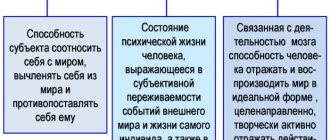What is it in psychology: definition of the concept
Consciousness is the highest form of the human psyche, formed and developed under the influence of socio-historical conditions in the process of communication and work activity of a person.
It is also called the generalizing element of all mental acts .
Indeed, in the activity of the psyche there are no separate phenomena and acts, since they are all interconnected, although they retain their inherent specificity.
Let us also consider the main characteristics of this concept:
- separation of subject and object, that is, a person understands what belongs to the “I” and what does not;
- reflection, using various cognitive processes (such as thinking, perception, imagination, sensation, etc.) of the world that surrounds a person;
- ensuring aspirations in human activity. This is due to the fact that he becomes able to understand his motives and desires, set goals for himself, make the required adjustments and make the necessary efforts;
- emotional-evaluative attitude to all aspects of life;
- self-esteem both of one’s own actions and in relation to oneself in general.
Stream of consciousness is a term introduced by the philosopher W. James, which means a certain stream of sensations, thoughts, memories, continuously arising and intertwining with each other.
This concept comes from the fact that this process is involuntary and continuous , it is impossible to stop it. In addition, the term is often used in relation to an individual's internal dialogue.
Psychology of consciousness
Subject: Conscious phenomena (sensations, ideas, feelings, ideas) and acts
Representatives: Wilhelm Wundt, William James, Franz Brentano, Edward Bradford Titchener
The psychology of consciousness was not a holistic approach. Rather, it was a conglomeration of several research paradigms, united by a common subject and agreement in the view of psychology as the science of “direct experience” (W. Wundt).
Functional psychology of consciousness
Representatives: William James
Functional psychology (English: functional psychology) - a direction in psychology in the USA at the end of the 19th century - beginning of the 19th century. XX century, which declared the subject of psychological research to be the functions of mental processes, consciousness in behavior, in adaptation (adaptation) to the environment, to practical situations.
James used the “stream of consciousness” metaphor, which captured the dynamism of mental phenomena. Accordingly, analytical introspection lost its heuristic value: if you stop the stream of consciousness that was in the act of analytical introspection, it lost its properties and turned into a dead “slice” of the reality of mental life. James believed that the purpose of psychology was to study the adaptive function of consciousness. Consciousness, according to James, is a vital function of a person living in a complex environment. James introduced the “personal” dimension of consciousness, believing that conscious experience is always experienced as “mine,” as “belonging to me.”
The psychology of consciousness laid the foundations of scientific psychology as an independent discipline. Wrongfully narrowing the class of mental phenomena, limiting them only to conscious experience, the psychology of consciousness nevertheless formulated many laws of the functioning of the psyche, which have not been refuted to this day.
For James, consciousness was an adaptive act created by nature to survive in changing conditions. Consciousness, according to W. James, is not a flat picture, but a certain changeable, continuous flow of functional acts, which can only be stopped based on the laws of short-term memory.
Flow has the characteristic of being limited. There is also an important property of the flow - the choice of objects to which it is directed, selectivity. The selective property of consciousness and attention according to James are one and the same. That is, attention is a continuous, changeable, highly individual and selective flow. Physiological conditions of attention are:
1. Excitation of the cortical (ideational) center by external sensory stimulation forms the so-called preperception (anticipation of the object of attention), which is attention. Preperception (image creation) is half of the perception (perception) of the desired object. That is, simply put, we see only those objects that we perceive.
2. The sense organ must be adapted to the most distinct perception of external impressions (through the adaptation of the corresponding muscular apparatus). In the case of adaptive movements, an organic feeling of tension of attention appears, which we usually consider as a feeling of one’s own activity. Therefore, any object capable of arousing our sensitivity causes adaptation of the senses and, consequently, a feeling of activity, and an increase in the clarity of this object in consciousness.
The mechanisms of attention according to James depend on the degree of voluntary attention. Involuntary attention involves tuning the senses, sensitization, changing the circulatory system, etc., that is, something that has an adaptive value to the stimulus in order to achieve its greater clarity. In the case of voluntary attention, we are talking about the ideation center, which forms a state of readiness in relation to the environment, a state of preperception, the expectation of finding and selecting a weak signal in the conditions of solving a problem.
Structural psychology of consciousness
Structural psychology is a term introduced by E. Titchener to designate his psychology, which was opposed to functional psychology.
Representatives: Wilhelm Wundt, Edward Bradford Titchener
Its main authors are Wilhelm Wundt (1832-1920) and Edward Bradford Titchener (1867-1927).
The method of structural psychology is analytical introspection - a description of experiences in the categories of elements of consciousness.
The main task of psychology (according to W. Wundt) is to decompose the direct experience of consciousness into elements, highlight the connections of the elements with each other and determine the laws of these connections. The elements of consciousness are sensations, ideas and feelings.
The description of all types of feelings, in turn, fits into three-dimensional space, which consists of coordinate axes:
- pleasures - displeasures;
- voltage – discharge;
- excitement - calm.
The main processes of the psyche, the result of the creative synthesis of which is consciousness, are the processes:
- the process of direct reflection of objective reality by the senses (perception)
- an active process through which consciousness realizes its potential for self-organization at a qualitatively different level than the simple sum of its elements and leads to the formation of meaningful and ordered sets of mental elements (apperception).
Simultaneously with Wundt's structural psychology, the theory of acts of consciousness of Franz Brentano (1838-1917) developed. The main subject in it was not the content and structure of consciousness, but the activity of consciousness. Brentano also tried to find units of the psyche, but found them in elementary mental acts. Brentano published his fundamental work “Psychology from an Empirical Point of View” in 1874.
Under the influence of Wundt and Brentano, an original direction arose within the psychology of consciousness - the Würzburg school, whose representatives concentrated on the problem of thinking.
Emergence
When did psychology emerge as a science of consciousness?
The term “consciousness” appeared in the works of ancient philosophers.
But only at the end of the 19th century, researcher V. Wund proposed using it as a subject of psychology . Thus begins a new direction - psychology as the science of consciousness.
V. Wund became the founder of classical psychology of consciousness, combining the ideas and achievements of his predecessors in this field. It was he who managed to organize a holistic scientific psychological school.
The essence of this direction is that the phenomena of this act cannot be reduced to physical stimuli affecting the subject. Mental life is distinguished by the presence of original causes.
Gradually narrowing the class of mental processes, representatives of this direction were able to discover a number of important laws of the functioning of the psyche.
Thus, the direction under consideration ultimately acted as the basis for identifying psychology as an independent discipline.
How to communicate with the subconscious? Read about it here.
Psychology as a science. History of the development of psychology
1.1. Psychology as a science, object and subject of psychology
Currently psychology
(from ancient Greek soul; knowledge) is defined as
- “the science of the patterns of development and functioning of the psyche as a special form of life activity” [, P. 274];
- a field of scientific knowledge that studies the patterns of emergence, formation and development of mental processes, states and properties of humans and animals;
- “a certain ordered view of events related to the internal, mental, mental, spiritual life of a person, as well as to the field of human (and animal) behavior” [, P. 10].
The immediate goal of psychological research
is the study of the role of mental functions in individual and social behavior, as well as the physiological and neurobiological processes underlying cognitive activity and behavior of people.
The object of psychology as a science in the broad sense is man.
Object
Psychology is the psyche,
the subject
is the basic laws of the generation and functioning of mental reality.
Psyche
- This
- “a systemic property of highly organized matter, which consists in the subject’s active reflection of the objective world, in his construction of a picture of the world that is inalienable from him and self-regulation on this basis of his behavior and activities” [, P. 265];
- “a general concept denoting the totality of all mental phenomena” [, P.34].
At different stages of development of psychological knowledge as a subject of psychology
various phenomena were considered: the soul, phenomena of consciousness, the direct experience of the subject, the unconscious, behavior, etc. (Fig. 1.1).
Subject of psychology
–
- “the natural connections of the subject with the natural and sociocultural world, imprinted in the system of sensory and mental images of this world, motives prompting action, as well as in the actions themselves, experiences of their relationships to other people and to themselves, in the properties of the individual as the core of this system” ( A.V. Petrovsky, [, P. 6]);
- “facts, patterns and mechanisms of the psyche as a reflection of reality in the brain, on the basis and with the help of which behavior and activities that have a personal character in a person are controlled” [, P.7];
- concrete facts of mental life and mental phenomena.
Rice.
1.1. Subject of psychology
Psychic phenomena
– subjective experiences or elements of the subject’s internal experience.
There are four groups of mental phenomena:
processes, states, properties and formations.
Mental process
– an act of mental activity that has an object of reflection and a regulatory function. Mental processes act as primary regulators of behavior.
Psychic reflection
– the process of forming an image of the conditions in which some activity is carried out.
Rice.
1.2. Types of mental processes
Mental condition
(English mental state) – “an internal holistic characteristic of the individual psyche, relatively unchanged over time” [, P.92].
Mental states are formed on the basis of mental processes and characterize the state of the psyche as a whole. In Fig. 1.3 presents classifications of types of mental states on various grounds.
Rice.
1.3. Types of mental states
Mental properties
– “individual psychological characteristics that determine the constant ways a person interacts with the world” [, P.92]. They are characterized by stability and constancy, determine the uniqueness of a person and are the basis of his personality (examples of properties: temperament, character, personal abilities).
Psychic formations
– the result of the development of the human psyche; they are the result of his acquisition of life and professional experience. Examples of mental formations: knowledge, competencies, habits, beliefs, values.
Mental processes, states and properties form the main conceptual “framework” of modern psychological science.
Subject of study
The subject of psychology has changed along with the development of this discipline , constantly expanding and supplementing.
At first it was the science of the soul - this explained everything that was incomprehensible to man and that could not be rationally explained.
But the formation of a scientific direction is connected precisely with the term “consciousness”. This definition was studied and interpreted by various researchers, for example, J. Locke believed that this is the very first thing a person discovers in himself.
So, the subject of research of this phenomenon was considered by many scientists. At the end of the 19th century, experiments began to be actively carried out. The most significant of them were the experiments of W. Wundt, whom we already mentioned above.
What is the psychological mechanism of self-awareness?
Personal self-awareness is the individual’s understanding and assessment of himself as an individual and a subject of cognitive and practical activity.
In other words, a person distinguishes himself from the entire surrounding world and determines his place in it. The formation and development of personality is important in this concept.
This concept has a direct connection with society and human activity , since it does not arise in a person immediately, but develops in the process of his development under the influence of many social factors.
It is worth noting that the definition in question is also closely related to reflection , which acts as its psychological mechanism.
Reflection is understood as a person’s thoughts about himself, about his life and his purpose.
However, its levels can be very different . So, this can be a simple understanding of oneself or deep thoughts about the content and meaning of one’s existence.
BodyPsychologyBody psychology
Psychology of consciousness is the science of the properties of consciousness, its elements, connections between them and the laws to which they obey. The most important functions and properties must be derived from the structure of consciousness. What is the content of consciousness? It is very diverse. The central area of consciousness that is clear and distinct is the “focus of consciousness”; and beyond it there is another area, with unclear and indistinct content - the “periphery of consciousness.” The contents of these areas are in constant flux.
The German psychologist W. Köhler described his content of consciousness, which included images of the immediate surrounding world, images of memories, feelings of one’s strength and well-being, and acute negative emotional experiences.
W. James identified two types of states of consciousness: stable and changeable, i.e. those images on which our thoughts stop and we reflect; and quickly passing, i.e. those thoughts that replace each other. V. James compared the whole process with the flight of a bird, in which periods of calm soaring are combined with flapping wings. He also put forward the idea of the “stream of consciousness” as a continuously changing process, describing its properties: continuity, variability, the impossibility of “entering the same river.” The fact of internal experience is that some conscious processes are taking place. States of consciousness are replaced by one another in it. Within the boundaries of personal consciousness, its states are changeable (states of consciousness are unique, since both the subject and the object have changed, objects are identical, not sensations). Every personal consciousness represents a continuous sequence of sensations. It perceives some objects willingly, rejects others, makes a choice between them - this is a process of attention. In the stream of consciousness, impressions are not equal in importance. There are more, there are less significant. The contents of consciousness are related to interests, hobbies, habits and intentions. And those that are more significant direct the flow as a whole. He believed that consciousness is indivisible into elements, and that each part of the stream of thought, as a subject, remembers the previous ones, knows the objects known to these parts, concentrates its concerns on some of them as its own, and assigns to the latter all other elements of knowledge.” Performing the function of adaptation, consciousness overcomes the difficulties of adaptation when the stock of reactions (reflexes, skills and habits) is insufficient: it filters stimuli, selects significant ones from them, compares them with each other and regulates the behavior of the individual. Being personally isolated, individual consciousness forms the basis of personality as “an empirically given aggregate of objectively knowable things.”
W. Wundt, a German psychologist, physiologist and philosopher, founded the world's first experimental psychology laboratory in 1879 at the University of Leipzig. Based on an understanding of psychology as the science of direct experience, discovered through careful and strictly controlled introspection, he tried to isolate the “simplest elements” of consciousness. These are objective elements (coming from the outside, from the object) - simple impressions, sensations and ideas that have the following properties: quality, intensity; subjective (associated with the subject, his internal experiences) - feelings, emotions, for which he identified 3 parameters: pleasure-displeasure; excitement-calming; voltage-discharge. Complex feelings are made up of these elements. Feelings provide a connection between elements, a synthesis of elements of consciousness: perception is the process of the entry of any content into the field of consciousness (associations, by similarity, by contrast, by temporal and spatial contiguity, cause-and-effect...) and apperception (associated with the area of clear vision) - concentration of consciousness (attention) on any content, i.e. the content falls into the realm of clear consciousness. The organization of a higher order unit is an act of apperception (letters into words, words into phrases, etc., i.e., the unification of small units of consciousness into large ones). W. Wundt also established the basic laws of mental life:
Pages: 1
History of development and areas of application of factor analysis. A brief outline of the history of the development of factor analysis. Factor analysis is a branch of mathematical statistics. The common misconception about factor analysis as a psychological theory has its own reason: factor analysis originated and has always been intensively used in psychological science. Its initial goal was to build mathematical models using...
The role of individual psychological characteristics of students in the process of mastering future professional activities. The first condition is the nature of the activity itself or the content of the task that the teenager has to solve. Not every activity and not every task causes him strong motivation. The strongest desire for achievement arises if the activity is novel, if there are opportunities for the student to demonstrate...
Experimental study of the characteristics of reflection in the educational activities of university students. Objectives, methods and results of the experiment By specifying the hypothesis put forward, we set the goal of the experimental study to study the property of reflexivity in its relationship with the already identified general abilities: intelligence, learning ability and creativity, as well as with their more specific manifestations. In accordance with the task, diagnostic methods were selected...
Property of highly organized matter
Many researchers agree that consciousness can be characterized as a product or property of highly organized matter , that is, a person. The nature and essence of the connection between a property and matter itself is being actively studied in various disciplines.
At the same time, it is quite often characterized as a property of the brain. But this definition is wrong. The fact is that the brain is primarily a biological organ.
Consciousness is formed under the influence of social factors. Therefore, it is more correct to define it as a property of such highly organized matter as a person.
Properties of consciousness.
S. L. Rubinstein identifies the following properties of consciousness:
* building relationships;
* cognition;
* experience.
Each act of consciousness can rarely be either only cognition, or only experience, or only attitude; more often it includes these three components. However, the degree of expression of each of these components is very different. Therefore, each act of consciousness can be considered as a point in the coordinate system of these three most important psychological categories. See: Rubinstein S. L. Being and consciousness. - M., 1957.
When analyzing the mechanisms of consciousness, it is important to overcome the so-called brain metaphor. Consciousness is a product and result of the activity of systems, which include both the individual and society, and not just the brain. The most important property of such systems is the possibility of creating the functional organs they lack, a kind of new formations that, in principle, cannot be reduced to certain components of the original system. Consciousness must act as a “superposition of functional organs.”
Properties of consciousness as a functional organ:
* reactivity;
* sensitivity;
* dialogism;
* polyphony;
* spontaneity of development;
* reflexivity.
Functions of consciousness.
The main functions of consciousness include the following:
* reflective;
* generative (creative, or creative);
* regulatory and evaluation;
* reflective;
* spiritual;
Literature.
1. Platonov K.K. About the system of psychology. - M.: Mysl, 1972.
2. Rubinstein S. L. Being and consciousness. - M., 1957.
Psyche, psychophysiology and psychodiagnostics
Concepts such as “psyche” and “consciousness” are closely related. Let's try to understand this issue.
So, if we consider the definition of the psyche in its broad sense, as the space of the inner world of a person, then, in this case, consciousness should be characterized as the highest form of the psyche , that is, as all the phenomena that a person is aware of and of which he is aware.
But quite often these definitions are interpreted in a narrower sense. Then the psyche is more likely directed towards the external world, and consciousness - towards the internal.
As a psychophysiological phenomenon, it is one of the most complex manifestations of brain functioning.
Self-awareness occupies an important place in the structure of the discipline . As we noted earlier, this is a process during which the subject becomes able to determine the attitude towards himself and know himself.
Psychodiagnostics of self-awareness is aimed at identifying its product of the subject’s idea of himself. In this case, you can use the following psychodiagnostic methods :
- Self-report - performed in the form of descriptions of one’s feelings and emotions.
- Checklists - lists of qualities are offered and from them a person needs to choose those that are most suitable for him.
- Questionnaires - include various statements about the subject’s attitude towards himself in various areas of life. He needs to determine how much he agrees with them in accordance with the scale developed for the questionnaire.
- Free self-descriptions imply subsequent analysis and processing.
What is the unconscious according to Freud? Find out the answer right now.
Definition of consciousness by various directions in psychology
Currently, psychology is represented by many scientific schools, and a unified approach to the subject of study is extremely difficult due to the lack of a common basic conceptual apparatus. Each direction determines human consciousness in the light of its own research method.
— Structuralism defines consciousness as a multicomponent concept that consists of the simplest basic elements of the psyche. By compiling a conditional “periodic table of elements”, it will be possible to create an accurate map of the consciousness of any person.
— Functionalism views consciousness as an important function inherent in the inhabitants of the complex structured environment that is modern human society. An integral part of consciousness is personal, consciously experienced and comprehended experience.
—
Gestalt psychology considers consciousness to be the result, the sum of the transformation of physical stimuli according to the laws of Gestalt.
— Behaviorism considers consciousness to be the internal reactions and behavioral characteristics of a person, formed by his habits and the surrounding social environment.
— Cognitive psychology defines consciousness as a logical process of cognition, as opposed to emotional perception. Information is either processed independently or marked and subsequently perceived in accordance with the established marker.
Altered states
An altered state of consciousness is understood as a special state of a person, which is unusual for him and noticeable to others.
For a better understanding, we note that normal states include wakefulness and sleep.
The altered consciousness differs from clear and normal consciousness in that the individual loses the ability for clear self-determination.
disturbances in ordinary thinking appear ; a person acts more according to feelings and certain images. He loses his sense of time and sometimes reality.
Altered states, if they are experienced briefly, are a characteristic property of a healthy psyche.
They can be caused in various ways. However, sometimes they appear as a result of some pathology.
Basically, the occurrence of an altered state uses various chemistry, such as ethyl alcohol (alcohol), drugs (for example, marijuana, cocaine, medications, etc.). At the same time, they are most often caused by the person himself of his own free will.
If the altered state occurs frequently and not from the use of chemical substances, then most likely we are talking about mental illness.
<… contentScore=”7702″> cut the entire edge of the table with a knife, looking ahead with shining eyes and thinking about her” [112, vol. IX, p. 102].[quote] It is unnecessary to remind that all the world’s lyrics are filled with descriptions of emotional states, the subtlest “movements of the soul.” Here is at least this excerpt from the famous poem by A.S. Pushkin: And the heart beats in ecstasy, And for it, And deity, and inspiration, And life, and tears, and love have risen again. Or from the poem by M. Yu. Lermontov: A burden falls from the soul, Doubt is far away - And one believes and cries, And so easily, easily... So, this is the complex reality that psychologists ventured to study at the end of the last century. How to conduct such a study? First of all, they believed, it is necessary to describe the properties of consciousness
.
The first thing we discover when looking at the “field of consciousness” is the extraordinary diversity of its contents, which we have already noted. One psychologist compared the picture of consciousness to a flowering meadow: visual images, auditory impressions, emotional states and thoughts, memories, desires - all this can be there at the same time. However, this is not all that can be said about consciousness. Its field is heterogeneous in another sense: a central region clearly stands out in it, especially clear and distinct; this is the “ field of attention
”, or the “
focus of consciousness
”;
outside it there is a region whose contents are indistinct, vague, undifferentiated; this is the “ periphery of consciousness
.”
Further, the contents of consciousness that fill both described areas are in continuous movement. V. James
, who wrote a vivid description of various phenomena of consciousness, distinguishes two types of its state: stable and changeable, quickly passing.
When we, for example, think, our thoughts dwell on the images in which the subject of our reflection is clothed. Along with this, there are subtle transitions from one thought to another. The whole process is generally similar to the flight of a bird: periods of calm soaring (stable states) are interspersed with flapping wings (variable states). Transitional moments from one state to another are very difficult to catch by self-observation, because if we try to stop them, then the movement itself disappears, and if we try to remember them after they are over, then the bright sensory image that accompanies stable states overshadows the moments of movement. V. James reflected the movement of consciousness, the continuous change of its contents and states in the concept of “ stream of consciousness
”.
The flow of consciousness cannot be stopped; not a single past state of consciousness is repeated. Only the object of attention can be identical, and not the impression of it. By the way, attention is maintained on an object only if more and more new aspects are revealed in it. Further, it can be found that the processes of consciousness are divided into two large classes. Some of them occur as if by themselves, others are organized and directed by the subject. The first processes are called involuntary
, the second -
voluntary
.
Both types of processes, as well as a number of other remarkable properties of consciousness, are well demonstrated using the device that W. Wundt used in his experiments. This is a metronome; its direct purpose is to set the rhythm when playing musical instruments. In W. Wundt's laboratory, it became practically the first psychological device. V. Wundt suggests listening to a series of monotonous clicks of the metronome. You can notice that the sound series in our perception involuntarily becomes rhythmic. For example, we can hear it as a series of paired clicks with an accent on every second sound (“tick-tock”, “tick-tock”...). The second click sounds so much louder and clearer that we can attribute this to an objective property of the metronome. However, this assumption is easily refuted by the fact that, as it turns out, it is possible to arbitrarily change the rhythmic organization of sounds. For example, start hearing an accent on the first sound of each pair (“tak-tick”, “tak-tick”...) or even organize sounds into a more complex four-click beat. rhythmic
in nature , concludes V. Wundt, and the organization of rhythm can be either voluntary or involuntary [20, p.
10]. With the help of a metronome, W. Wundt studied another very important characteristic of consciousness - its “ volume
”.
He asked himself the question: how many separate impressions can consciousness accommodate at the same time? Wundt's experiment consisted of presenting a series of sounds to the subject, then interrupting him and giving a second series of the same sounds. The subject was asked: were the rows the same length or different? At the same time, it was forbidden to count sounds; you just had to listen to them and form a holistic impression of each row. It turned out that if the sounds were organized into simple measures of two (with emphasis on the first or second sound of the pair), then the subject was able to compare rows consisting of 8 pairs. If the number of pairs exceeded this figure, then the rows disintegrated, that is, they could no longer be perceived as a whole. Wundt concludes that a series of eight double beats (or 16 separate sounds) is a measure of the volume of consciousness
.
Then he puts on the following interesting and important experiment. He again asks the subject to listen to sounds, but randomly organizes them into complex bars of eight sounds each. And then repeats the procedure for measuring the volume of consciousness. It turns out that this time the subject can hear five such measures of 8 sounds as a complete series, i.e. 40 sounds in total! With these experiments, W. Wundt discovered a very important fact, namely, that human consciousness is capable of being almost infinitely saturated with some content if it is actively united into larger and larger units. At the same time, he emphasized that the ability to enlarge units is found not only in the simplest perceptual processes, but also in thinking. Understanding that a phrase consisting of many words and an even larger number of individual sounds is nothing more than an organization of a higher order unit. Wundt called the processes of such organization “ acts of apperception
.”
So, a lot of painstaking work has been done in psychology to describe the overall picture
and
properties
of consciousness: the diversity of its contents, dynamics, rhythm, heterogeneity of its zero, volume measurement, etc. Questions arose: how to explore it further?
What are the next tasks of psychology? And here a turn was made that eventually led the psychology of consciousness to a dead end. Psychologists decided that they should follow the example of the natural sciences, such as physics or chemistry. The first task of science, scientists of that time believed, was to find the simplest elements
.
This means that psychology must find the elements of consciousness, decompose the complex dynamic picture of consciousness into simple, then indivisible, parts. This is the first thing. The second task is to find the laws of connection of the simplest elements. So, first decompose consciousness into its component parts, and then reassemble it from these parts. This is how psychologists began to act. W. Wundt declared individual impressions, or sensations
.
For example, in experiments with a metronome these were individual sounds. But he called pairs of sounds, i.e. those very units that were formed due to the subjective organization of a series, complex elements, or perceptions. Each sensation, according to Wundt, has a number of properties or attributes. It is characterized primarily by quality (sensations can be visual, auditory, olfactory, etc.), intensity, extent (i.e. duration) and, finally, spatial extent (the last property is not inherent in all sensations, for example, it is present in visual sensations and absent from auditory ones). Sensations with their described properties are objective elements
of consciousness.
But they and their combinations do not exhaust the contents of consciousness. There are also subjective elements
, or feelings.
V. Wundt proposed three pairs of subjective elements - elementary feelings: pleasure-displeasure, excitement-calm, tension-release. These pairs are independent axes of three-dimensional space of the entire emotional sphere. He again demonstrates the subjective elements he has highlighted on his favorite metronome. Suppose the subject organized sounds into certain beats. As the sound series is repeated, he constantly finds confirmation of this organization and each time experiences a feeling of pleasure. Now, suppose the experimenter greatly slowed down the rhythm of the metronome. The subject hears a sound and waits for the next one; he feels a growing sense of tension. Finally, the click of the metronome comes - and there is a feeling of release. The experimenter increases the clicks of the metronome - and the subject has some additional internal sensation: this is excitement, which is associated with the accelerated rate of clicks. If the pace slows down, then calmness occurs. Just as the pictures of the external world that we perceive consist of complex combinations of objective elements, i.e., sensations, our internal experiences consist of complex combinations of the listed subjective elements, i.e., elementary feelings. For example, joy is pleasure and excitement; hope - pleasure and tension; fear is displeasure and tension. So, any emotional state can be “decomposed” along the described axes or assembled from three simple elements. I will not continue the constructions that the psychology of consciousness dealt with. We can say that she did not achieve success on this path: she was not able to assemble living, full-blooded states of consciousness from simple elements. By the end of the first quarter of our century, this psychology practically ceased to exist. There were at least three reasons for this: 1) it was limited to such a narrow range of phenomena as the content and state of consciousness; 2) the idea of decomposing the psyche into its simplest elements was false; 3) the method that the psychology of consciousness considered the only possible - the method of introspection - was very limited in its capabilities. However, the following should be noted: the psychology of that period described many important properties and phenomena of consciousness and thereby posed many problems that have been discussed to this day. We will consider in detail one of these problems raised by the psychology of consciousness in connection with the question of its method in the next lecture.
Study problem
In the structure of scientific knowledge, this concept and its research are distinguished by several significant difficulties that arise for researchers. This is especially true for direct study of its nature.
The main problems of this concept include:
- unlike other mental functions, it is not localized in time and space. As a result, certain difficulties arise in its research in certain areas of science;
- psychological phenomena appear in a person immediately at the moment when he begins to realize them.
In addition, it should be noted that the term itself did not have a clear description and definition .
It was the difference between conscious mental processes and unconscious ones.
In other words, this was the name given to a certain coloring that accompanies most mental acts .
Only after a large amount of time the organization of this mental act was changed and supplemented. So, now this included such components as an object and a sign, included in the structure of this concept.
Thus, despite the problems of consciousness, it is still considered to be the highest level of understanding of mental processes and self-regulation that a person has.







